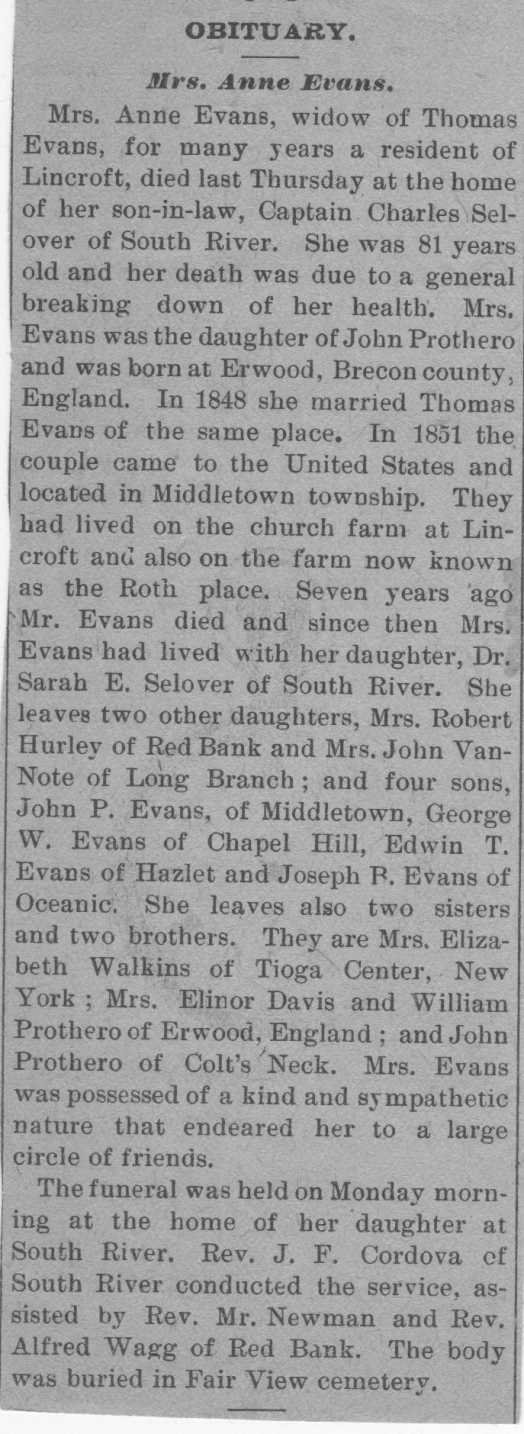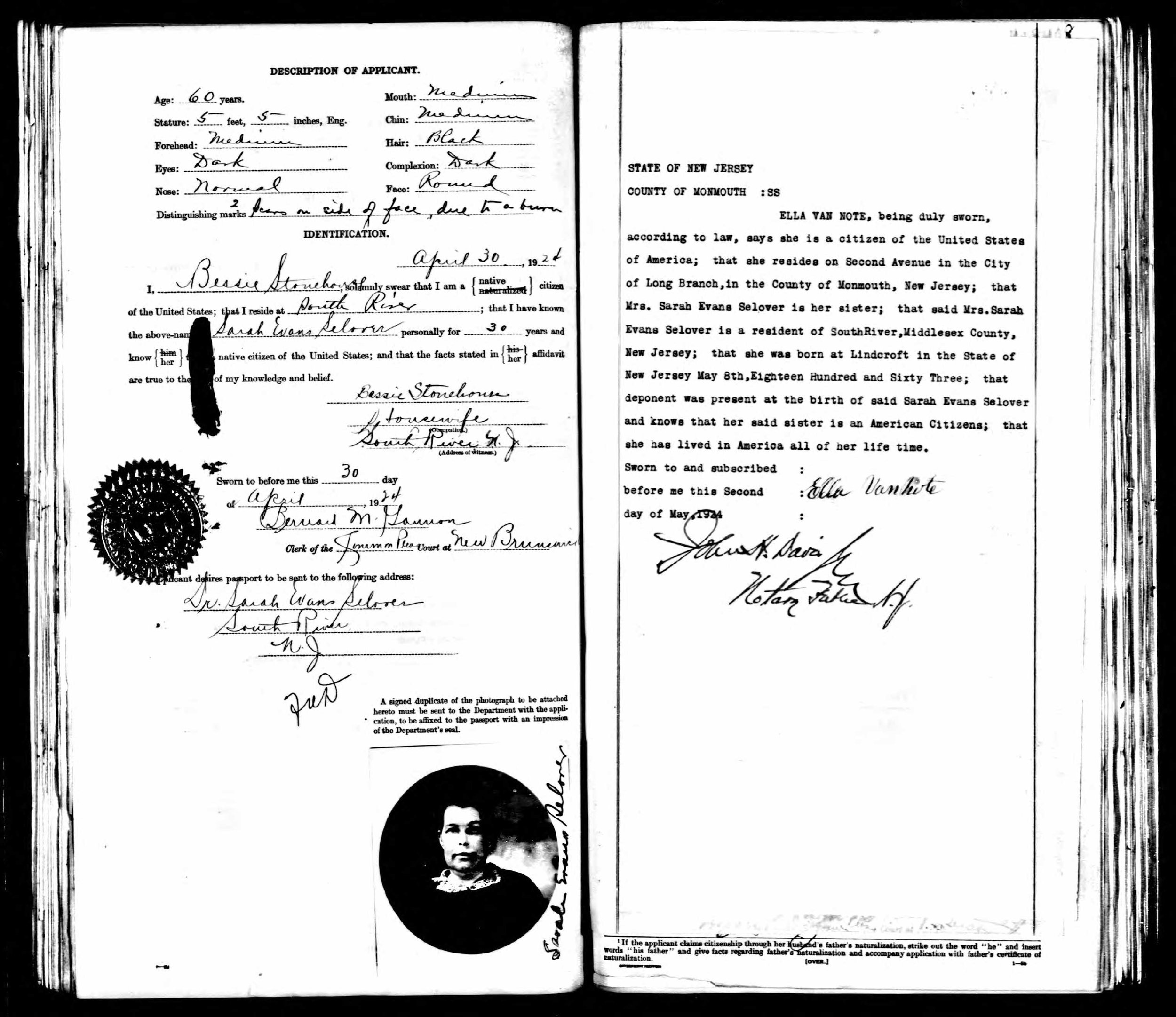The Chosen Families Project #24: Renowned Female Physician and Suffragette: Dr. Sarah Evans Selover - RETURNED
Hello!
Welcome to another episode of the Chosen Families Project
I recovered this photograph in an antique store in Asbury Park, NJ.
The photograph is of a woman in her early 20s, with dark brown curly hair pinned up, wearing a dark shirt. The photograph was taken by Excelsior Gallery in Lewisburg, Pennsylvania. The back of the photograph lists Dr S. Evans Selover. After doing some research, I was able to locate more information on her, and discovered that she was a prominent suffragette and physician in New Jersey. I was able to then return this photograph to the South River Historical & Preservation Society , who wrote about her before.
Here is the story of Dr. Sarah E. Evans Selover:
Sarah was born on May 8, 1863 in Lincroft, New Jersey to parents Thomas Evans and Anne Prothero. Her father was born on July 17, 1819 in Rodonshire, South England her mother, Anne Prothero on Jan 30, 1823 in Erwood, England. The couple married in 1848 in England, having 8 children total including Sarah, including Ella (1851), William (1853),Margaret (1854), John (1858),George (1860),Edwin (1862), and Joseph (1868). Her parents and her first 3 siblings immigrated to the United States by about 1851. By 1870, her father was working as a farmer in Middletown, Monmouth, New Jersey; Sarah was 7 years old. By 1880, she was residing with her brother John, also in Middletown, Monmouth, New Jersey, USA. In 1885 she was residing with her parents and brother Joseph in Middletown.
Brian Armstrong’s article titled “Dr. Sarah Evans Selover, the “Lady Doctor” published in June 2012 in South River Historical Preservation and News, tells further of her life following residing with her parents in 1885, when she sought her education.
“Shortly thereafter, she began her academic journey. She attended Peddie Institute in Hightstown and then entered Bucknell University where she taught higher mathematics and chemistry. Then she “became interested in the medical profession” and entered the College Preparatory School of Newark, NJ and later the New York Medical College where she graduated in 1893. After completing her degree, she spent a year as an intern in the New England Hospital for Women and Children in Boston Massachusetts.
The hospital was founded in 1862 in “an effort to overcome the obstacles that stood in the way of women entering medical practice” by providing them a “competitive advantage” with clinical training in “cutting edge of contemporary medical pedagogy.” She came to South River in 1894 on the “advice of friends” and opened an office. The development of Sayreville and South River industrial factories may have increased the population and the need for additional doctors in the area.
The photograph was likely taken at her time at Bucknell University, which was located in Lewisburg Pennsylvania. Two years after her arrival to the South River, on April 20, 1896, she married Charles H. Selover, a successful “boatsman” from the borough who was 22 years her senior,” born in 1840.
Soon after her marriage, her father would pass away on the 26 Nov 1896 in Lincroft. He is buried in Fair View Cemetery in Middletown
Headstone of Thomas and Anne Evans
By 1900, she resided with her husband Charles and mother in South River, New Jersey, with a blossoming practice on Main Street, beginning as early 1894 according to the 1915 Annual Report for the New York Infirmary for women and children Dr. Selover worked as a physician and surgeon at this address until 1930 according to census records.
Armstrong’s article tells further of her practice, and what she did for the community in South River:
Dr. Selover began to distinguish herself and develop a trust with the community due to her professionalism and experience. She had a “kindly disposition; tenacity of purpose and promptness in caring for her patients.” She treated many patients in their homes and made house calls until they were well. Newspapers noted her treatment of children with dog bites, injuries from falls, burns from bathwater, throat burns from carbolic acid, and sprained wrists from roller skating. Adult injuries included cuts from being buried under clay, broken ribs from falling off a ladder, stabbing wounds, and a steam roller burn to the face. In all cases, she quickly served the patient by dressing the wound, performing small medical procedures and finally sending the patient to a hospital, if required.
Some cases put her in the position of only being able to help people in their final moments of life. Charlotte Dow Barber recalled “Old Doc Selover’s” “rambling gray house” at 115 Main Street which included her “somewhat gloomy, sparely-furnished office.” During office visits, “her long, billowing, woolen skirt reached down to the tips of her high-buttoned shoes and under the skirt she wore two flannel petticoats in one of which was sewed a large pocket.
When a patient would reimburse her, she would lift up her skirt and deposit the money in her petticoat.” Barber also recalled that for most house calls someone was sent to get Dr. Selover because of the lack of telephones in the town. She would arrive driving her horse and buggy and later a Model-T Ford with solid, perforated rubber tires. She endured the rough ride to ensure that she would always be able to reach her patients quickly. Dr. Selover would first inquire about the health of the family and then administer castor oil, before any other medications were prescribed.
For minor injuries such as black eyes, a leech was prescribed from a local pharmacy. Although Selover was compassionate, she also had a stoic, no nonsense demeanor with little tolerance for children and vocal pregnant woman who did not “suffer in silence.” Her aim was to keep her patients alive, free of pain, and help them heal as soon as possible.
Her practice reached far beyond the borough with patients in Milltown, Spotswood, Old Bridge, Sayreville, and Jamesburg. Patients that moved often traveled great distances to return to her for treatment from Asbury Park to Reading PA, and Northern New Jersey.
Dr. Selover also worked as a medical examiner. Armstrong states that:
Joseph Karcher noted that Dr. Selover appeared in court as a medical expert to help patients who had been in auto accidents obtain damages. She was also asked to testify in other court cases. Newspapers noted her ability to endure a court session with “one of the best crossexaminers at the bar”, former Judge C.T. Cowenhaven. The case involved an assault where Selover’s testimony was necessary to convict the accused of stabbing the victim in the back rather than injuring him with a defensive frontal wound. She was “equal in quick thinking and ready answers” and “retired from the witness stand triumphant.”
Her mother Anne Evans would pass away on April 28, 1904 in South River, New Jersey. She is buried alongside her husband in Fair View Cemetery. Her obituary from the Red Bank Register on 4 May 1904 states….
Dr. Selover’s husband, Charles Henry Selover would pass away on Feb 12, 1913 also in South River. He is buried in Washington Monumental Cemetery.
HIs obituary, published on FindaGrave reads…
Anne Evans Obituary
Her husband, Charles Selover Obituary
Dr. Selover was also active during the 1918 Influenza Epidemic. This epidemic took over 50 million lives worldwide.The Covid-19 pandemic, which draws similarities to this historical epidemic, has taken over 6 million worldwide. Armstrong describes that:
“She put her own safety at risk and alone handled more than 450 cases, “beginning early in the morning and working until midnight, taking no thought of her own comfort with regard to meals or sleep.” To give people a sense of security, she wore “a long oil skin raincoat” while out on these calls, and quickly removed it and stored it in her stable/garage before entering her house and office. “ This bears similar to countless medical staff who worked countless medical hours during the recent pandemic in order to help save lives.
Dr. Selover's most notable work includes her work as a suffragette. She was “active in the Tabernacle Baptist Church and was a supporter of women’s suffrage. She was the Master of Ceremonies when a noted suffragette speaker came to speak at the Tabernacle Baptist Church in 1915. She was interested in intellectual pursuits and supported the Chautauqua when it came to Sayreville in 1916. Newspapers called her “an ardent suffragette” and a “leading suff.”
A photograph dated from 1920 held at Rutgers University Library, courtesy of the South River Historical and Preservation Society titield “JUNE SICKNICK, “FUTURE PRESIDENT,” WITH HER MOTHER, EDNA KELLER SICKNICK” describes the movement in South River at this time, and how Dr. Selover’s work contributed to it:
Sarah Evans Selover, a local physician, was one of the leaders of South River’s Equal Suffrage League. While many affluent women were often involved in suffrage groups, working class mothers like the one in this photograph also joined the campaign. South River’s women voted in school elections as early as 1913. Seven of the 167 ballots cast that year came from female voters who, according to the newspaper, cast their ballots "without fear or trembling," which the newspaper noted was in contrast to stereotypes about female timidity. Six years later, women cast more than half of the school election ballots. In September 1915, the local suffrage group formed. Such was their success that a month later, when New Jersey put the issue of suffrage to a state vote by the people, the suffrage amendment was rejected by a margin of one vote in South River. The rejected amendment represented a major turn for a place that was expected to follow the majority of the state. After the 19th Amendment became federal law in August 1920, South River women were quick to take advantage. 265 South River women voted in the primary election in September, and 535 voted in the general election in November.
In May of 1924, Dr. Selover applied for a passport to Europe. This passport application includes another photograph of her. She was described as a “born diplomat and had friends of all political, cultural and ethnic backgrounds.” She was also “interested in civic affairs and knew every phase of government of the town.”
Passport Application With Photograph
In May of 1924, Dr. Selover applied for a passport to Europe. This passport application includes another photograph of her. She was described as a “born diplomat and had friends of all political, cultural and ethnic backgrounds.” She was also “interested in civic affairs and knew every phase of government of the town.”
According to Armstrong, sometime in the winter of 1932, she had:
“received a midnight call from “a sick patient near death” that had been passed over by other doctors. Dr. Selover “shoveled and dug her way to the home” of the sick person arriving in time to save their life. Soon after, she became very ill and went to the home of her niece, Mrs. E. Thurston Blaisdell of Long Branch.”
Dr. Sarah E. Selover would pass away on 5 April 1932, at the age of 48. Her life was celebrated with the community, as well as within the North East.
Dr. Selover’s funeral was held at the Tabernacle Baptist Church on April 8, 1932 and “over 50 percent of South River’s population passed by her casket and viewed the remains of their friend who had relieved the suffering of men, women and children alike.”
The Daily Record April 8 1932
Obituary New York Times
April 6 1932
Obituary April 5, 1932
Keyport Enterprise | April 14, 1932
Obituary | The Central Jersey Home News April 5, 1932
Obituary | The Daily Record April 5, 1932
She is buried in Washington Monumental Cemetery aside her husband.
Dr. Sarah Evans Selover, despite the Great Depression, left behind an estate worth over $400,000 (worth almost 9 million today). Armstrong notes that “Joseph Karcher, who had the responsibility for auditing the accounts of her estate, said that “it would appear that although her fees for house calls were extremely low and she showed great dedication to her patients they were always apparently willing and able to pay her fees and thus enable her to build up such an impressive estate.”
I also found a court case decided on Apr 30, 1937, titled First National Bank, South River v. Hurley from the Court of Errors and Appeals regarding her estate. The main issue states that The only issue here is whether or not the executors are justified in paying to R. Edgar Hurley the sum of the two money legacies of $7,000 and one-third of $10,000 hereinbefore mentioned without first deducting therefrom the amount owed the estate from this defendant on account of his note” under the rule of law that “that a legatee indebted to a testator under whose will he is entitled to a legacy, shall accept his debt in payment of his legacy, or his legacy may be applied in discharge of his debt. This principle is founded in sound reason and justice.”
Other notes from the case:
Testatrix by codicil to her will directed her executors and trustees to extend the time for payment of the principal of the debt due from the legatee for a period of five years from her death. Held, testatrix intended the legatee to have the benefit of his legacy immediately upon the settlement of her estate and at the same time that other legatees received their respective legacies.
Legatee (Hurley) was entitled to receive his legacy upon the passing of executors' intermediate account. Payment of such legacy directed, together with interest from the date of the passing of the intermediate account, less deduction of accrued interest on debt due from legatee.
"The bill is for the construction of the will and codicils thereto of Sarah Evans Selover, who died at South River, New Jersey, on April 5th, 1932, and instructions touching the payment of certain legacies to the defendant R. Edgar Hurley are also sought.
"The decedent's estate was of the approximate value of $400,000, more than one-half of which was disposed of by numerous money bequests to close relatives. After an intermediate accounting in the orphans court of Middlesex county in August, 1933, the executors paid all legacies except those to the defendant R. Edgar Hurley, touching which the court's instructions are now sought. The estate is in funds for the payment of the R. Edgar Hurley legacies also, and the residuary estate which, of course, still remains in the hands of the executors undistributed, is valued at $131,402.08. By the seventh paragraph of her will the testatrix, among other bequests, bequeathed to her nephew, R. Edgar Hurley, the sum of $7,000 and also to the three children of her deceased sister, Margaret, of whom R. Edgar Hurley was one, the sum of $10,000. R. Edgar Hurley is also one of the residuary legatees, he being entitled to a one-eighteenth interest in the residue
"That is undoubtedly the rule of law in this state; but obviously, I think, the very purpose of the quoted clause in the second codicil was to avoid the application of this rule to the debt due the testatrix from the defendant R. Edgar Hurley. After reciting the debt she says: "I do hereby direct my said executors and trustees * * * to extend the time of payment of the principal sum of said obligation for a period of five years from the date of my death," and she then provides for necessary arrangements for the payment of interest and the prevention of the running of the statute of limitations. Had the law not been as laid down in Denise v. Denise, supra, there would have been no necessity for this direction to the executors. It is clear, I think, that testatrix intended that her nephew should have the benefit of this legacy immediately upon the settlement of her estate and at the same time that other legatees receive their respective legacies
I am not sure what the overall judgment was, but it seems that it was in favor of Hurley.
Overall, I can’t believe I was able to recover a photograph of such a profound woman, who for her time, not only became a physician, but also utilized her abilities of power and trust in the community in order to help women earn the right to vote. Thanks to an article by Armstrong, I was able to contact the South River Historical & Preservation Society, and I was able to return the photograph to them. They mentioned they had limited photographs of her, only found in newspaper articles like I mentioned above.
If you have any questions or comments please reach out to me at thechosenfamiliesproject@gmail.com
Take Care!
















